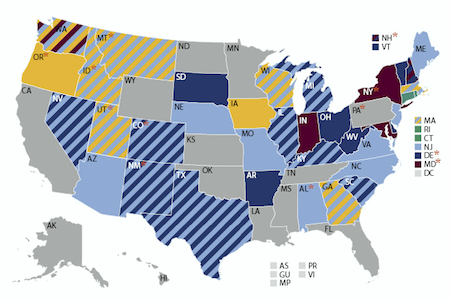BCAP Provides Nice Energy Code Resources for 10 Special States

 BCAP is the Building Codes Assistance Project, the organization that provides the Online Code Environment and Advocacy Network (OCEAN). I wrote about them last year and all the great work they do, including their weekly email updates* for those who want to keep up with what’s happening in the world of energy codes. Recently they partnered with the energy offices in 10 states to provide some customized energy code resources for those states.
BCAP is the Building Codes Assistance Project, the organization that provides the Online Code Environment and Advocacy Network (OCEAN). I wrote about them last year and all the great work they do, including their weekly email updates* for those who want to keep up with what’s happening in the world of energy codes. Recently they partnered with the energy offices in 10 states to provide some customized energy code resources for those states.
BCAP is the Building Codes Assistance Project, the organization that provides the Online Code Environment and Advocacy Network (OCEAN). I wrote about them last year and all the great work they do, including their weekly email updates* for those who want to keep up with what’s happening in the world of energy codes. Recently they partnered with the energy offices in 10 states to provide some customized energy code resources for those states.
For example, Alabama residents can get checklists and guides for homeowners, home inspectors, home buyers, and construction industry professionals. There’s also a consumer pamphlet and special versions of most of these materials just for Baldwin and Mobile Counties. All of these are available for download in pdf format.
The 10 states included in this project are Alabama, Alaska, Idaho, Kentucky, Maryland, Michigan, Missouri, Nebraska, Pennsylvania, and Texas. If you live or work in one of those states, check it out.
I’ve looked through the materials for Alabama, our neighbor, and overall they look great. The checklists and guides make it easy for the non-professionals to understand, and the pro guides give useful info to those who are new to some of the energy efficiency and building science concepts.
I did find one thing I didn’t like, though: a photo of a man installing fiberglass batt insulation on foundation walls in a crawl space. I know some people do this, but I wouldn’t recommend fiberglass for crawl space foundation walls where they could get wet. I hope they’ll change it for a better photo of crawl space encapsulation with more appropriate materials.
thing I didn’t like, though: a photo of a man installing fiberglass batt insulation on foundation walls in a crawl space. I know some people do this, but I wouldn’t recommend fiberglass for crawl space foundation walls where they could get wet. I hope they’ll change it for a better photo of crawl space encapsulation with more appropriate materials.
Besides that, the rest of the material I looked at is really good and definitely worth downloading and using.
In addition to the special resources for these 10 states, the BCAP website has tons of other great info. For example, if you want to know what energy code your state is using or where it is in the implementation of that code, they’ve got you covered. Here’s the implementation map, where you click on your state to check out how well you’re doing. (Click the map below to go to the BCAP map.)
BCAP is definitely a resource that any self-respecting energy geek needs to have bookmarked. If you’re not a self-respecting energy geek, I’ll let you dwell on these words from Aretha Franklin:
Oh (Sock it to me, sock it to me,
sock it to me, sock it to me)
A little respect (Sock it to me, sock it to me,
sock it to me, sock it to me)
Whoa, babe (Just a little bit)
A little respect (Just a little bit)
*Sign up for BCAP’s weekly email newsletter by sending an email request to mkerns at ase dot org.
Related Articles
Building Codes Assistance Project — Your Source for Energy Code Info
This Post Has 5 Comments
Comments are closed.



Thanks for calling out the
Thanks for calling out the photo of the pink batt installation in a crawlspace/basement – it’s these residual visuals that give homeowners all kinds of bad information!
Thank you for the post. The
Thank you for the post. The materials for Alabama will be helpful to my business. Saving me time. Also like Heather’s comment.
BCAP does do a wonderful job
BCAP does do a wonderful job but you might also want to mention the huge amount of energy info that’s available on DOE’s web site, energy codes.gov. I am constantly amazed at the amount of energy information that’s available between these two sites!
I have to agree that putting
I have to agree that putting fiberglass insulation on the walls of a crawl space is not a good idea. Crawl space water is a common problem.
I have to agree that putting
I have to agree that putting fiberglass insulation on the walls of a crawl space is not a good idea. Water in a crawl space is a common problem.